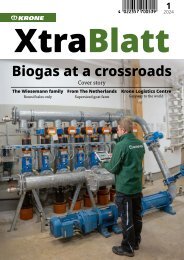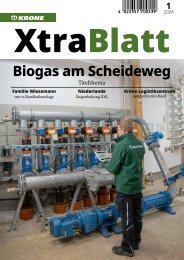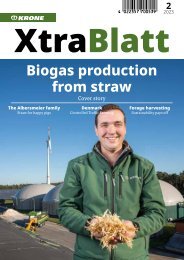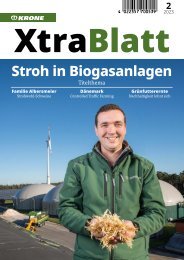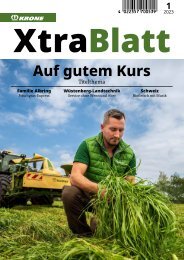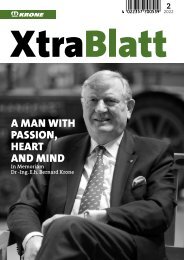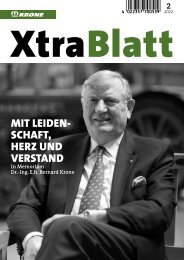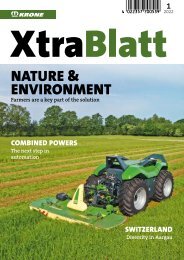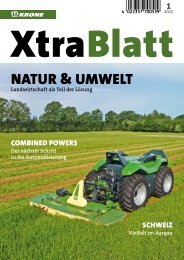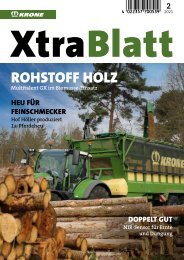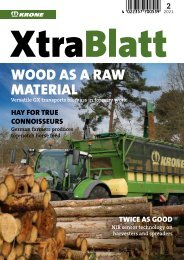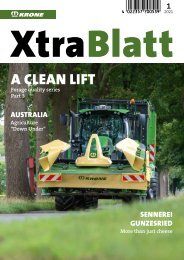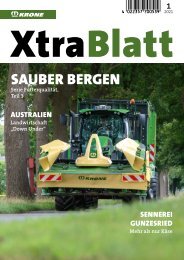XtraBlatt Issue 01-2023
Create successful ePaper yourself
Turn your PDF publications into a flip-book with our unique Google optimized e-Paper software.
Farming organically<br />
only makes sense when<br />
you have animals.<br />
Hasi Strahm<br />
The farmer sells the<br />
meat from his Aubrac<br />
cattle and home-produced<br />
pork from his<br />
vending machines and<br />
also to individual retail<br />
customers such as a<br />
hospital.<br />
The feed passage is<br />
regularly replenished<br />
with the hay crane.<br />
The animals are<br />
fed only hay and<br />
second-cut hay.<br />
Side note<br />
He regularly works with<br />
a group of young people<br />
to tackle long-rooted<br />
weeds on the grassland<br />
and arable fields. “The<br />
youngsters do various<br />
tasks around the farm<br />
to earn a bit of pocket<br />
money,” he says. “Armed<br />
with a dock weeder,<br />
they go out in the spring<br />
and pull up docks.”<br />
It has to be organic<br />
Hasi Strahm cares deeply for his animals, and the<br />
whole concept of organic farming. “And farming<br />
organically only makes sense when you have<br />
animals,” he stresses. “I need to spread manure<br />
on the fields if I want to harvest a crop. I don’t want<br />
to take from the land all the time. I have to give<br />
back as well.” For example, on average he harvests<br />
between 80kg and 120kg of maize kernels per “are”<br />
(approx. 8t/ha), after applying 40m³ of manure in<br />
the spring. “I’m more interested in cycles than high<br />
yields.” He articulates his approach to farming,<br />
which is both his philosophy and elixir of life: “To<br />
the best of my ability, I want to live with nature,<br />
rather than against it. And I like the fact that my<br />
farm is largely self-sufficient – apart from certain<br />
feed I buy in, such as mineral licks, or coarse grain<br />
to distract the cows while the calves are being<br />
tagged in the field.”<br />
“My farm is forage-heavy and no-till,” Hasi Strahm<br />
points out. “I grow arable crops on 38ha, 24ha<br />
of which is given over to forage production.” He<br />
reserves 3.5ha for biodiversity measures and<br />
ecological areas. The rest of the land, close to the<br />
shed, is down to permanent pasture. “My four-year<br />
crop rotation is deliberately non-intensive: Grass<br />
leys in the first year for forage production, followed<br />
by wheat, a forage catch crop, maize and then leys<br />
again.”<br />
And here too, his main focus is the circular economy.<br />
“This crop rotation builds up humus,” Hasi<br />
Strahm points out. “I no longer produce silage<br />
bales from the final cut, if I do one at all.” For a<br />
few years now, he has been leaving the third cut<br />
to the soil organisms. “In this way, earthworms<br />
and other creatures make more humus for me,” he<br />
maintains. In autumn, he applies another load of<br />
manure to the grass ley with a muck spreader. “To<br />
prepare the seedbed for maize, I do several passes<br />
with a spring-tooth harrow,” he explains, “The<br />
tractors run on duals to protect the soil.”<br />
Four to five days after drilling the maize, he runs<br />
the tine weeder over the seedbed, weather permitting.<br />
He knows from experience that this strategy<br />
removes 80% of the weeds. And immediately after<br />
drilling, he sets up his crow scarer. “Crows are a<br />
danger before the four-leaf stage.”<br />
Krone machinery by choice<br />
The cattle are free to feed 24h a day – with music<br />
playing in the background the whole time, from<br />
classical tunes to pop songs and at maximum<br />
68dB. Hasi Strahm is convinced that this improves<br />
their quality of life. To produce organic meat, the<br />
Aubracs take a little longer to reach their ideal<br />
finishing weight. He sets out the timescale: “My<br />
bullocks are ready at around 24 months – by then<br />
they have the right proportion of fat to muscle. In<br />
the stall they are fed hay and the second cut (we<br />
call this the Emd). In summer, they are mainly<br />
pasture-fed.” Most of the first cut is stored in the<br />
hay dryer. The second cut is dried in the sun and<br />
turned into square or round bales.<br />
Hasi Strahm understands the value of having<br />
good equipment. He’s been a great fan of Krone<br />
haymaking equipment for many years, which he<br />
sums up as follows: “I am impressed by the quality<br />
and durability of the machines. In 2021, I bought<br />
an EasyCut B 870 CV, which is the ideal machine for<br />
my style of grassland management,” he stresses.<br />
Stress-free meat<br />
So how does he slaughter the animals without<br />
stress? “I shoot the cattle in the shed myself,” he<br />
explains (he is an experienced marksman). Three<br />
to four months before they reach their slaughter<br />
weight, he takes them off the pasture in preparation.<br />
“During these months I leave the animals<br />
here in the shed so they don’t notice anything.”<br />
Before shooting an animal, he distracts it by offering<br />
an extra portion of hay; then he hides behind<br />
a mobile shooting table around ten metres away.<br />
His rifle is equipped with a telescopic sight – and a<br />
silencer: “That’s how it has to be,” says Hasi Strahm.<br />
Although the other cattle hear the muffled shot,<br />
they don’t associate it with anything and therefore<br />
don’t take fright. “Of course, it’s quite another<br />
matter when the animals are slaughtered in the<br />
abattoir with huge amounts of stress hormones<br />
flooding their system. And that affects the<br />
flavour of the meat,” he explains, speaking from<br />
experience.<br />
According to Swiss law, a veterinary must be<br />
present at the slaughter to inspect the carcass. A<br />
butcher must also be on hand to make the breast<br />
cut. Thirty seconds after being shot, the animal is<br />
already hanging from the crane to bleed and will<br />
then be towed on a sledge to the transport trailer.<br />
“The butcher and I drive to the abattoir 12km away,”<br />
explains Hasi Strahm. And then he drives home<br />
again with the quartered animal and bones it himself.<br />
“I vacuum-pack the prime cuts such as fillets,<br />
back and entrecôte, but I turn most of the meat<br />
into mince,” he says. He sells frozen meat from a<br />
vending machine – as burgers or sausages in packs<br />
of three. He processes on average one animal per<br />
month, in other words around 200kg of meat “net”.<br />
“As a one-man operation, that’s exactly the right<br />
workload for me,” he remarks. In addition, the<br />
catering department of a local hospital purchases<br />
another carcass every five to six weeks.<br />
Hasi Strahm’s shed obviously wouldn’t be complete<br />
without solar panels. The two roof sections of the<br />
building together generate nearly 500,000 kW of<br />
solar power. “I use one tenth myself and export the<br />
rest to the grid – at a price that is fixed for 25 years,”<br />
he says. This is how the farm will be handed down<br />
to the next generation in the foreseeable future.<br />
When exactly, the farmer does not say. «<br />
Hasi Strahm prefers to<br />
use Krone machines<br />
for haymaking.<br />
28 1|<strong>2023</strong> <strong>XtraBlatt</strong><br />
<strong>XtraBlatt</strong> 1|<strong>2023</strong><br />
29



